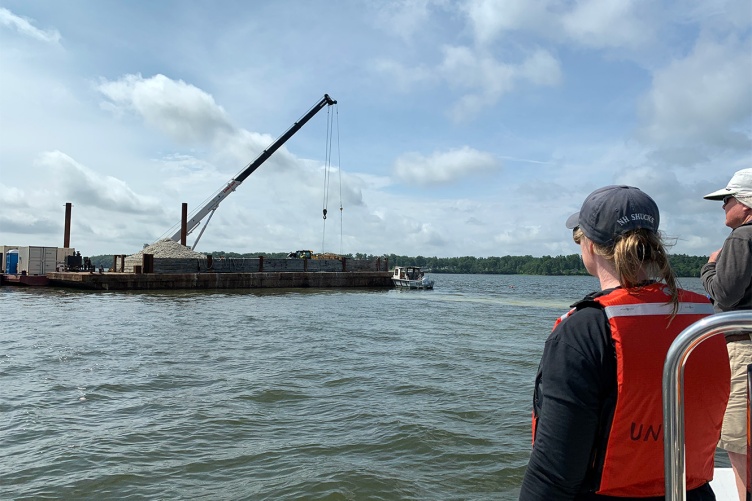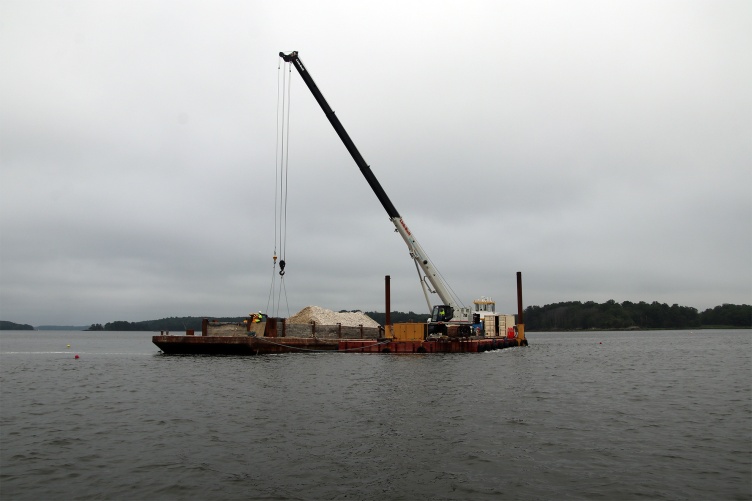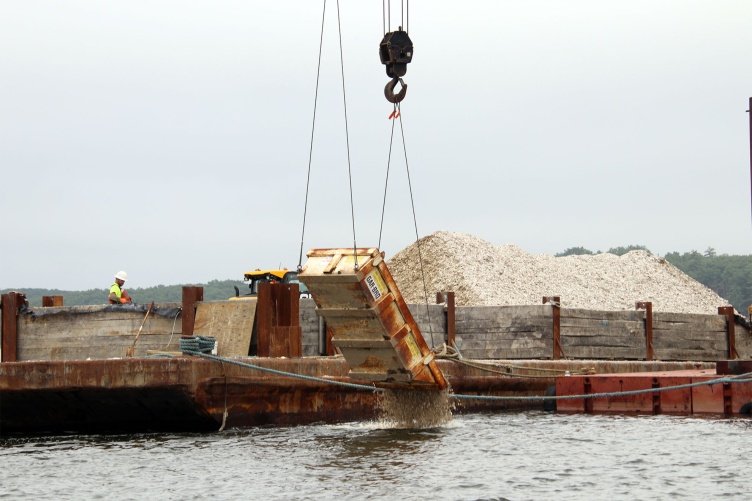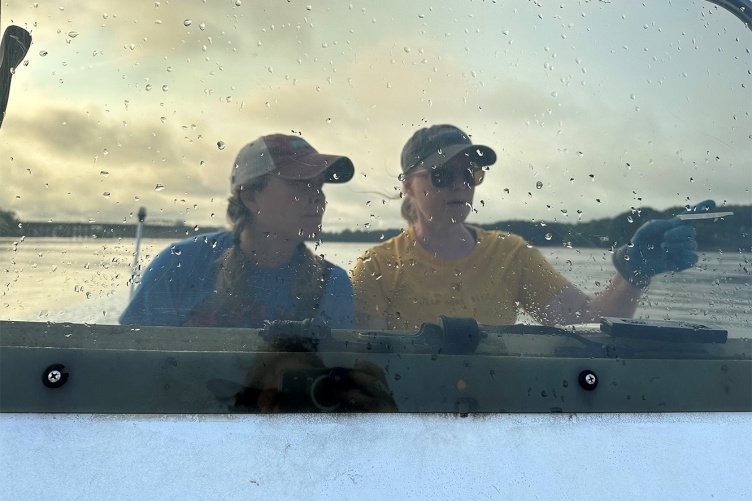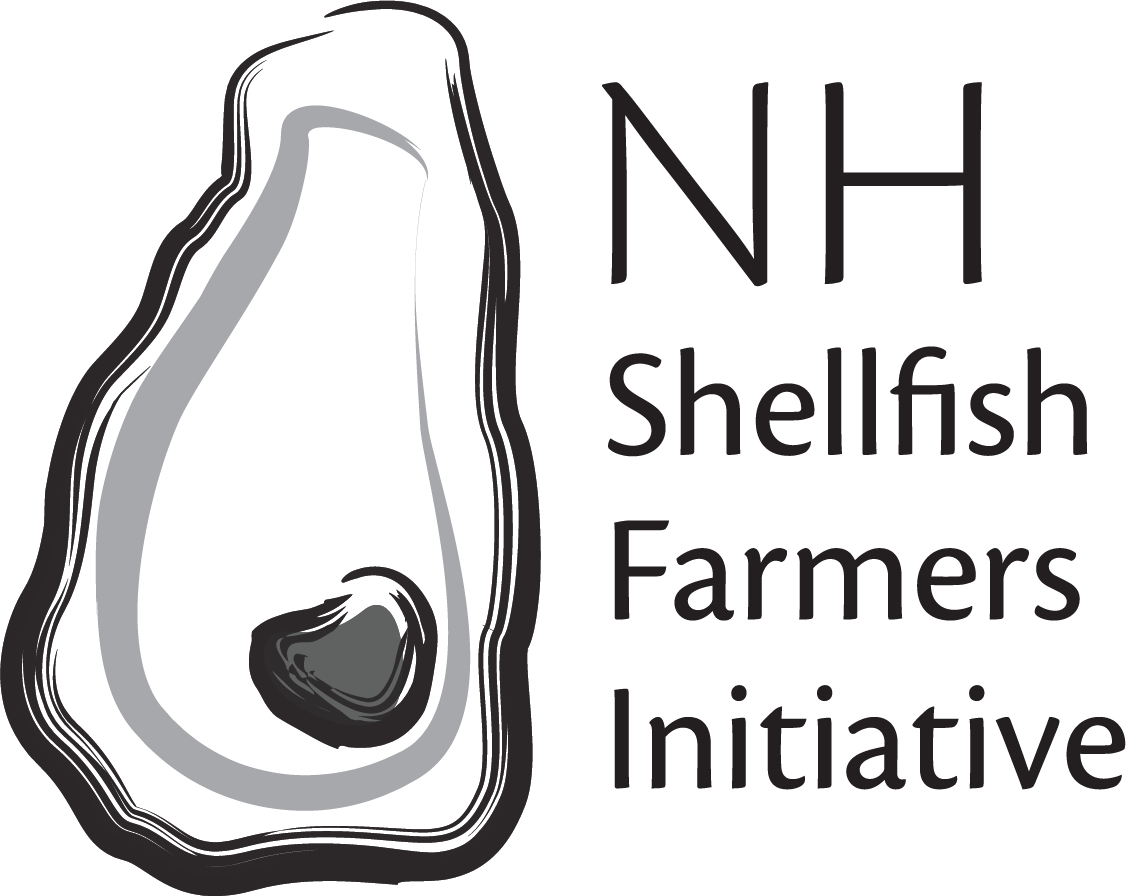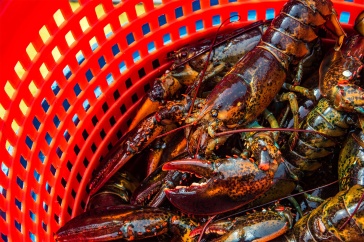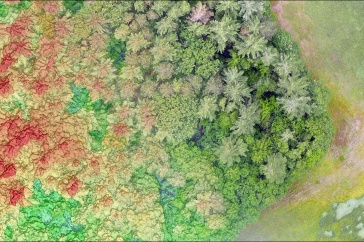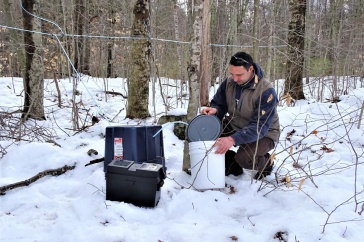Project Goal
Support ongoing annual oyster restoration in New Hampshire’s Great Bay Estuary by installing and growing oyster reefs for oyster larvae to attach to the reef and mature.
The Lifecycle of an Oyster: Veliger, Spat, Adult
Adult oysters release both eggs and sperm into the water, resulting in fertilized eggs that develop into free-swimming larvae called veligers. The microscopic veligers drift in the water, feeding on phytoplankton for several weeks to months. During this time, they metamorphize, which allows them to attach to rocks, shells and other hard surfaces. Once attached, the spat can grow up to an inch in their first year. Read more
After settling, the larvae undergo further transformation into juvenile oysters, also known as spat. These juvenile oysters attach themselves firmly to substrate and begin to grow into mature oysters. Over time, they develop a hard shell and filter feed on microscopic algae and organic particles from the surrounding water and grow into adult oysters. The entire oyster lifecycle can take several years, and individual oysters can produce millions of eggs and sperm during that time.
Oysters continue to filter and grow throughout their adult lives, but their growth rate generally slows down as they get older. Environmental factors, such as water temperature — warmer water triggers reproduction and faster growth — and food availability, play crucial roles in how they grow and reproduce. Adult oysters can live for several years, even decades, depending on various factors like species, environmental conditions and predation. Their longevity allows them to continue filtering water and contributing to their ecosystem over an extended period.
Krystin Ward, a laboratory research supervisor at the UNH College of Life Sciences and Agriculture, navigates a small skiff from the pier at UNH’s Jackson Estuarine Laboratory, heading southward in New Hampshire’s expansive Great Bay Estuary. Piloting the boat across choppy, dark water and beneath a gray sky, she talks about working in oyster reef restoration in Great Bay — supporting the efforts of UNH Professor of Biological Sciences Ray Grizzle — and the beginnings of her own oyster farm, Choice Oysters, in 2011. She discusses the long-term collaborative effort to restore the bay’s oyster reefs, which covered as many as 1,000 acres in the 1970s but have gradually dwindled. Based on aerial surveying conducted in 2020, live natural oyster reefs now cover approximately 80 acres of New Hampshire’s Great Bay.
“When I began at UNH in 2005, Ray had already been doing oyster reef restoration in the bay for five years,” Ward says. “In 2009, we partnered with some major organizations, including the USDA’s Natural Resources Conservation Service (NRCS/USDA) and The Nature Conservancy (TNC), to really grow these efforts and to use a barge every summer to deposit several tons of oyster and clam shells on or near depleted beds, building them up so that oyster larvae will set and grow upon them.”
Don’t miss the Third Annual Oyster Week NH 2023, Sept. 17-23.
Brought to you by the NH Shellfish Farmers Initiative and sponsoring venues and organizations.
On this day, Ward and her sister (and fellow oyster farmer), Laura Brown, are checking on efforts by Riverside & Pickering Marine Contractors to deposit about 450 cubic yards of shells that have been stored and dried for at least 6 months to remove any remaining tissue near Nannie Island, situated just off the Great Bay National Wildlife Refuge in Newington, New Hampshire. The Nannie Island reef restoration project, which is being funded by the NRCS/USDA, has been ongoing since the 15-acre reef was closed to shellfish harvesting in 2021. From 2016 to 2021, Ward and Grizzle observed a nearly 90 percent reduction in the natural oyster reef at Nannie Island. However, by adding new beds and farmed oysters to the site, they’re hoping the effort will jumpstart the area’s native oyster population.
More Than Two Decades of Great Bay Oyster Restoration Efforts
“Our goal here, at Nannie Island, and at our restoration site at the mouth of the Squamscott River, is ultimately to get more oyster larvae into the water column and provide new substrate for the larvae to set upon,” Ward says. “We deposit the shell in early summer so that when the oysters begin breeding as the water warms — usually about July-August — the larvae they produce will have new area to set upon.”
Once the shells are added to the Nannie Island reef, another 50 cubic yards will be deposited at a restoration site near the mouth of the Squamscott River. In previous years, Ward and Grizzle led restoration efforts at the mouth of the Lamprey River, where they were able to grow the existing natural reef further up into the river.
“By working in these same areas, we can concentrate the shell substrate in a smaller region, creating deeper beds, instead of just fanning thinner layers of shell out over several acres,” says Ward. “Sedimentation can be a problem, but by putting the shell about a half foot from the floor, we can establish a good layer and make a big difference.”
And they’re already seeing that difference — both from large-scale deposits like the one at the Nannie Island reef and from smaller deployments of farmed oysters from farms in Great Bay Estuary’s Little Bay. Using underwater cameras, Ward and Grizzle monitor both the reef growth and the addition of new spat and juvenile oysters. The cameras allow them to know when an area has a good, solid substrate in place, and when the oysters in the area begin reproducing and growing the reef naturally by attaching and settling upon one another.
“For the Nannie Island reef, we’re beginning to see more spat settling on the living oysters, indicating that they’re growing the reef naturally,” Ward says. “If this trend continues, we’re hopeful that the oyster population may rebound and some of this area will be open to recreational harvest again.”
“A major step forward came as result of COVID when we were able to secure funding to purchase live oysters that couldn’t be sold by the local farmers because restaurants were largely closed,” explains Grizzle. “We have added those live oysters to reef sites and the results so far have been encouraging, mainly because the farmed oysters have higher survival rates and we’ve found greater concentration of spat in the areas where they’ve been deployed.”
“So partnering with local oyster farmers in the restoration of Great Bay’s wild oyster populations has been a critical step forward in these efforts,” he added.
How Oyster Farming Encourages Great Bay Restoration
Laura Brown, who’s owned and operated Fox Point Oysters in Great Bay Estuary’s Little Bay since 2012, says that farming oysters and helping conserve oysters in Great Bay are two concepts closely connected, and one can’t really be done without the other.
“I don’t think you can be an oyster farmer in this area without being an environmentalist to some degree too,” says Brown. “Being involved in the restoration effort has been a goal of mine over the years and one that I’m excited to pursue more now.”
Just the influx in oyster farms in Great Bay over the past decade have contributed to restoration efforts and increased biodiversity, says Ward.
“If you’re putting shell on the bottom, that’s creating a natural reef and building habitat for fish and other invertebrates — so you’ll see a lot more biodiversity in a reef structure than you would on a mudflat,” she adds. “Through research, we’ve found that even the oyster farms in Little Bay are acting like reefs and supporting greater diversity. It’s really neat to think about the impacts of local oyster farms toward supporting the overall health of Great Bay and its many tributaries.”
Restoration Partners
- Coastal Conservation Association — NH (CCA-NH) (Provides oyster shell from shell recycling program)
- Harding Metals Inc. (New Hampshire)
- M & W Livestock Farm (Rhode Island)
- NH Shellfish Farmers Initiative
- Pease Development Authority, Ports & Harbors
- Portsmouth Department of Public Works
- Riverside & Pickering Marine Contractors (New Hampshire)
- Scamman's Home & Garden
Current funding for oyster restoration led by Ray Grizzle and Krystin Ward comes from the USDA’s Natural Resources Conservation Service, The Nature Conservancy’s SOAR (Supporting Oyster Aquaculture and Restoration) program, the National Oceanic and Atmospheric Administration (NOAA), the City of Rochester and the New Hampshire Municipal Alliance for Adaptive Management.
-
Written By:
Nicholas Gosling '06 | COLSA/NH Agricultural Experiment Station | nicholas.gosling@unh.edu



















































